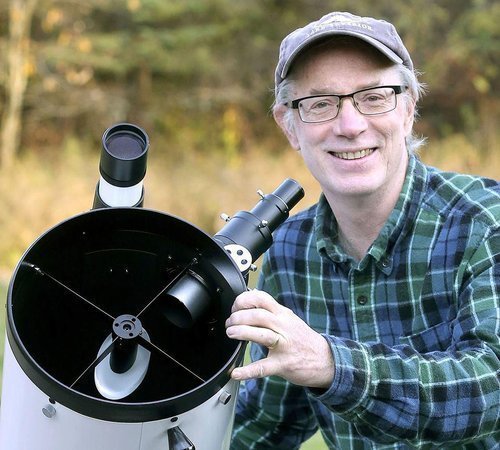November 2024 Night Sky Calendar
As the dipper-shaped Seven Sisters star cluster rises ever higher in the east this month, temperatures sink lower and lower. Being outdoors at night means packing gloves, a warm coat and even insulated boots, especially if you’re standing around waiting for an aurora to break loose.
This is a great time for planet-watching, with Venus low in the southwestern sky in evening twilight. Saturn appears next, about a third the way up the southern sky as soon as it gets dark. Even Jupiter rises early. When we return to standard time on Nov. 3 the giant planet gleams in the east around 8 p.m. local time.
Mars, which steadily brightens this month, shines from the dim constellation Cancer the Crab and hovers low in the east around 11 p.m. That comes to four bright planets before midnight a veritable cornucopia!
Comet Tsuchinshan-ATLAS, which put on a great show last month, lingers in the evening sky. We’ll see it best early in the month when the moon is absent or small. Be sure to bring binoculars as the comet has dipped to around magnitude 6.5, too dim to discern without optical aid.
This month’s featured constellation is Triangulum the Triangle. It has three stars and three sides – easy enough – and you’ll find it tucked below the constellation Andromeda. The W of Cassiopeia will help point you there. The ancient Greeks saw this stellar triangle as representing either the Nile delta or the island of Sicily, which approximates its shape. Although small, Triangulum is one of the easiest figures to see because it’s compact and simple. Give it a try!
Download the free Stellarium Mobile app for Android and iPhone to help you find and identify the planets, constellations and Comet Tsuchinshan-ATLAS, which is included in its database. Do a Google search then install the app, set it in night mode (red screen) and point your phone skyward. For a free November sky map and calendar go to www.skymaps.com/downloads.html
November 2024 night sky happenings
Events (a.m. indicates the event happens in the morning sky):
Nov. 1 – New Moon. Not visible because it’s near the sun in the daytime sky.
Nov. 1-9 – Comet Tsuchinshan-ATLAS slowly slides upward from the bell-shaped constellation Ophiuchus into Aquila the Eagle and should still be visible in binoculars from a dark sky before the moon grows too bright. Best viewing time is early evening right after dusk when the comet stands highest in the southwestern sky.
Nov. 3 – Daylight saving time ends at 2 a.m. local time.
Nov. 4 – Eye-grabbing conjunction of the crescent moon and Venus this evening. Both shine low in the southwestern sky at dusk.
Nov. 5 (a.m.) – Peak of the South Taurid meteor shower from midnight and dawn. If the weather doesn’t cooperate, the shower will be active for several mornings before and after, and the moon won’t interfere. About 10 meteors per hour flare at maximum, with fireballs common. Meteors will appear to stream from below the Pleiades cluster in Taurus.
Nov. 8 – First quarter moon. Even though you’ll see a half-moon it’s called first quarter because it’s completed a quarter of its orbit around Earth since new moon phase.
Nov. 10 – Very close conjunction of the waxing gibbous moon and Saturn! They’ll be a little more than a half-moon-diameter apart when closest around 8:30 p.m.CST.
Nov. 15 (p.m.) -16 (a.m.) – Full Beaver Moon. Watch for the moon to rise around sunset, shine all night near the Pleiades star cluster and set around sunrise the next morning. In the early morning hours of Nov. 16 between about 1:30 and 3:30 a.m. CDT, the moon will cross in front of and cover several of the cluster’s brightest stars. You can watch this in a small telescope.
Nov. 16 – Look for brilliant Jupiter below and left of the waning gibbous moon tonight.
Nov. 17 (a.m.) – Peak of the annual Leonid meteor shower in the early morning hours. Unfortunately, the waning gibbous moon will spoil the show.
Nov. 20 – Waning gibbous moon shines a few degrees to the left (east) of Mars late this evening from 11 p.m. local time into the morning hours.
Nov. 22 (a.m.) – Last quarter moon. Rises around 11:30 p.m. and stands approximately due south at sunrise.
Nov. 27 (a.m.) – Waning crescent moon occults (covers up) Virgo’s brightest star Times vary according to location. From Minneapolis the moon will stand just a few degrees above the eastern horizon when its sunlit edge occults Spica at 4:28 a.m. local time. The reappearance is much more dramatic because the star will pop out of the dark edge. That happens at 5:34 a.m. when the moon is much higher up. Full details at http://www.lunaroccultations.com/iota/bstar/1127zc1925.htm. Times shown are in UT (Universal Time). Subtract 5 hours for Eastern Time; 6 for Central; 7 for Mountain and 8 for Pacific.
Bob King is an amateur astronomer, author, and passionate educator. He served as a photographer and photo editor at the Duluth News Tribune for 39 years and taught at the UMD planetarium. Bob’s work had a great impact on Voyageurs National Park. To achieve International Dark Sky Park certification, the park was required to host dark sky education events. Through the Night Sky Explorer webinars, the Conservancy was able to fulfill this component and help secure the certification for Voyageurs National Park. We can’t thank Bob King enough for sharing his talents and knowledge with the Conservancy community to support dark sky preservation.







